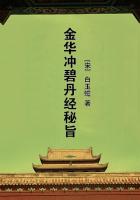It is plain, then, from the foregoing arguments that it is impossible for an infinite force to reside in a finite magnitude or for a finite force to reside in an infinite magnitude. But before proceeding to our conclusion it will be well to discuss a difficulty that arises in connexion with locomotion. If everything that is in motion with the exception of things that move themselves is moved by something else, how is it that some things, e.g. things thrown, continue to be in motion when their movent is no longer in contact with them? If we say that the movent in such cases moves something else at the same time, that the thrower e.g. also moves the air, and that this in being moved is also a movent, then it would be no more possible for this second thing than for the original thing to be in motion when the original movent is not in contact with it or moving it: all the things moved would have to be in motion simultaneously and also to have ceased simultaneously to be in motion when the original movent ceases to move them, even if, like the magnet, it makes that which it has moved capable of being a movent. Therefore, while we must accept this explanation to the extent of saying that the original movent gives the power of being a movent either to air or to water or to something else of the kind, naturally adapted for imparting and undergoing motion, we must say further that this thing does not cease simultaneously to impart motion and to undergo motion: it ceases to be in motion at the moment when its movent ceases to move it, but it still remains a movent, and so it causes something else consecutive with it to be in motion, and of this again the same may be said. The motion begins to cease when the motive force produced in one member of the consecutive series is at each stage less than that possessed by the preceding member, and it finally ceases when one member no longer causes the next member to be a movent but only causes it to be in motion. The motion of these last two-of the one as movent and of the other as moved-must cease simultaneously, and with this the whole motion ceases. Now the things in which this motion is produced are things that admit of being sometimes in motion and sometimes at rest, and the motion is not continuous but only appears so: for it is motion of things that are either successive or in contact, there being not one movent but a number of movents consecutive with one another: and so motion of this kind takes place in air and water. Some say that it is 'mutual replacement': but we must recognize that the difficulty raised cannot be solved otherwise than in the way we have described. So far as they are affected by 'mutual replacement', all the members of the series are moved and impart motion simultaneously, so that their motions also cease simultaneously: but our present problem concerns the appearance of continuous motion in a single thing, and therefore, since it cannot be moved throughout its motion by the same movent, the question is, what moves it?
Resuming our main argument, we proceed from the positions that there must be continuous motion in the world of things, that this is a single motion, that a single motion must be a motion of a magnitude (for that which is without magnitude cannot be in motion), and that the magnitude must be a single magnitude moved by a single movent (for otherwise there will not be continuous motion but a consecutive series of separate motions), and that if the movement is a single thing, it is either itself in motion or itself unmoved: if, then, it is in motion, it will have to be subject to the same conditions as that which it moves, that is to say it will itself be in process of change and in being so will also have to be moved by something: so we have a series that must come to an end, and a point will be reached at which motion is imparted by something that is unmoved. Thus we have a movent that has no need to change along with that which it moves but will be able to cause motion always (for the causing of motion under these conditions involves no effort): and this motion alone is regular, or at least it is so in a higher degree than any other, since the movent is never subject to any change. So, too, in order that the motion may continue to be of the same character, the moved must not be subject to change in respect of its relation to the movent.
Moreover the movent must occupy either the centre or the circumference, since these are the first principles from which a sphere is derived. But the things nearest the movent are those whose motion is quickest, and in this case it is the motion of the circumference that is the quickest: therefore the movent occupies the circumference.
There is a further difficulty in supposing it to be possible for anything that is in motion to cause motion continuously and not merely in the way in which it is caused by something repeatedly pushing (in which case the continuity amounts to no more than successiveness).
Such a movent must either itself continue to push or pull or perform both these actions, or else the action must be taken up by something else and be passed on from one movent to another (the process that we described before as occurring in the case of things thrown, since the air or the water, being divisible, is a movent only in virtue of the fact that different parts of the air are moved one after another): and in either case the motion cannot be a single motion, but only a consecutive series of motions. The only continuous motion, then, is that which is caused by the unmoved movent: and this motion is continuous because the movent remains always invariable, so that its relation to that which it moves remains also invariable and continuous.
Now that these points are settled, it is clear that the first unmoved movent cannot have any magnitude. For if it has magnitude, this must be either a finite or an infinite magnitude. Now we have already'proved in our course on Physics that there cannot be an infinite magnitude: and we have now proved that it is impossible for a finite magnitude to have an infinite force, and also that it is impossible for a thing to be moved by a finite magnitude during an infinite time. But the first movent causes a motion that is eternal and does cause it during an infinite time. It is clear, therefore, that the first movent is indivisible and is without parts and without magnitude.















